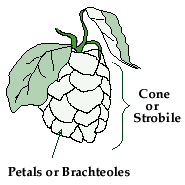
Many breweries boast adherence to the Reinheitsgebot (German Purity Law) of 1516 which decrees that beer may only include water, malted barley, yeast and hops. “What are hops?” you might ask. Hop is a twining vine that grows rapidly in the summer months and enjoys direct sunlight. The young shoots are eaten as a vegetable and the leaves are blanched and used as a soup. But hops are cultivated mainly for the brewing industry. Hops contribute bitterness and aroma to beer, but they were not always part of the brewing process. |

|
With the plethora of additives used to flavor beer, undoubtedly hops gained popularity for not only it’s bittering ability but also its role as an antiseptic and preservative. Hops helped to clarify the wort, provided a good head and improved a beer’s keeping power. Beer no longer required a high alcohol content to prevent spoilage – this meant the brewers needed less grain, which translated to higher profits.
The earliest references to hop cultivation are during the 8th and 9th century AD from the Hallertau district in Germany. Although it is not clear whether these hops were used in brewing, by the 14th century the Dutch had developed a taste for hopped German beer.
Medieval brewers were initially reluctant to use hops in beer, claiming it caused “melancholy and tormenting disease.” Hops should be avoided during depression. Hop tea is a nerve tonic, a mild sedative and a muscle relaxant. The estrogen content increases lactation and is an anaphrodisiac for men. Exported by the Flemings, hopped beer found its way across the English Channel in the early 1400s. Although hops were brought to England by the Romans for use as a vegetable, the English brewers were appalled at its use in beer. It was many decades before the merits of hopped beer were accepted and hops incorporated into mainstream brewing practices in England.
Hops were brought with the early 17th century colonies to North America. American colonists brewed with imported hops, spruce bark and sassafrass root, until 1629 when the Massachusetts Bay Co. ordered hop seeds from England. The colonists employed hops in many ways. They extracted wax for use as a reddish-brown dye, used the fibers for textiles and ate the young shoots. By 1859 nearly 90 percent of the hops used in the United States were grown in New York. But as land began to fill with farmers and cities, hop farms were pushed West. California’s Central Valley became a hop-growing region, and from there hop farms quickly spread North to Oregon and Washington where they are still commercially grown today.
In Continental Europe the wild male hop has been exterminated. The unpollinated female hop is higher in the alpha acids which give beer its bitter flavoring. The cone of the female hop is made of many overlapping petals. At the base of each petal is the seed where sticky yellow glands produce the resins and oils that provide aroma and bitterness. The petals also contain tannin which aids in clarifying the beer. Today one can find numerous strains of New World and Old World hops. The United States is second in hop production only to Germany! With a little practice you will begin to recognize the distinctive tastes of the different hop strains.
